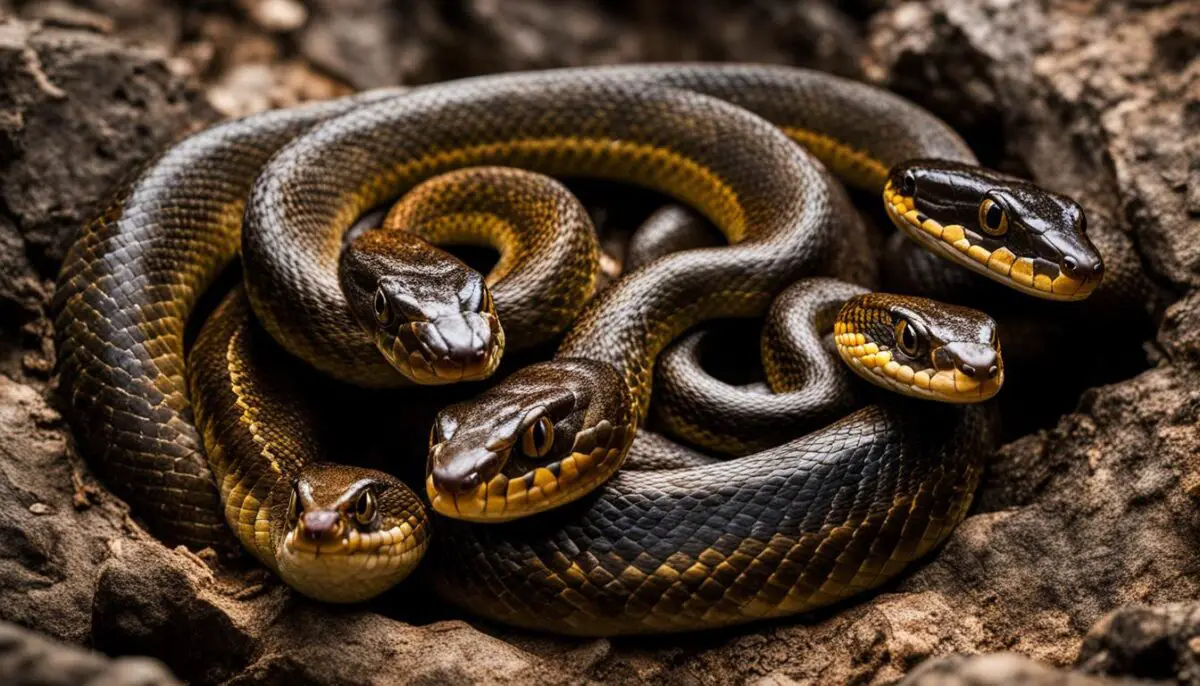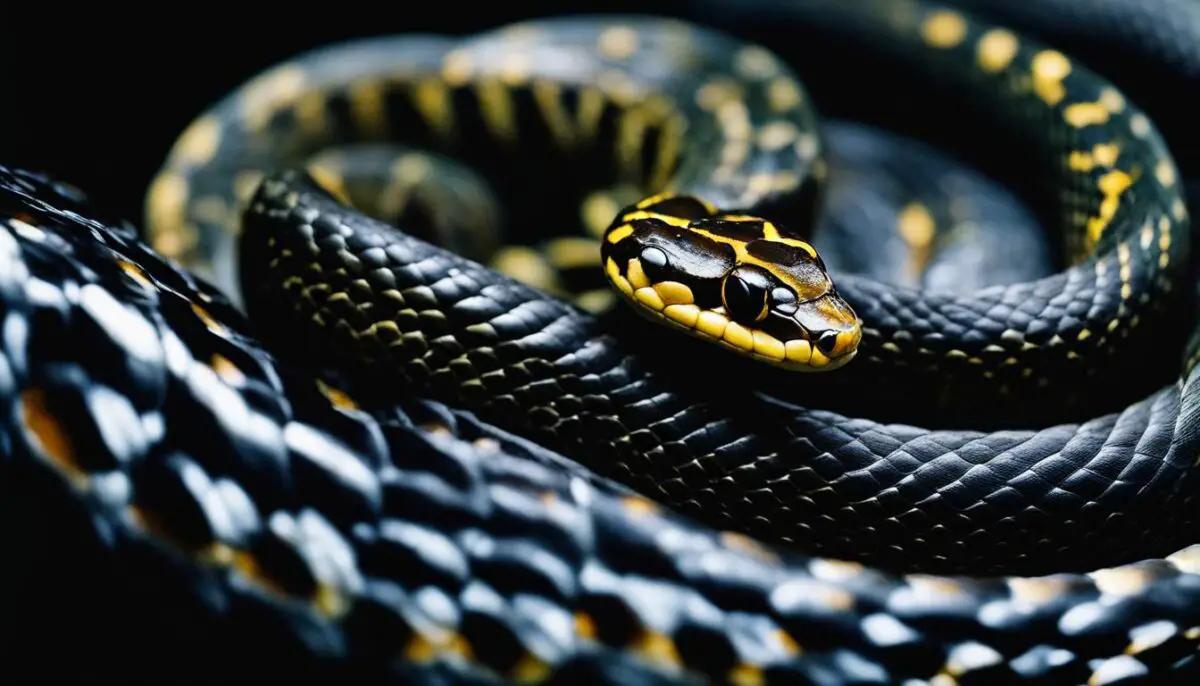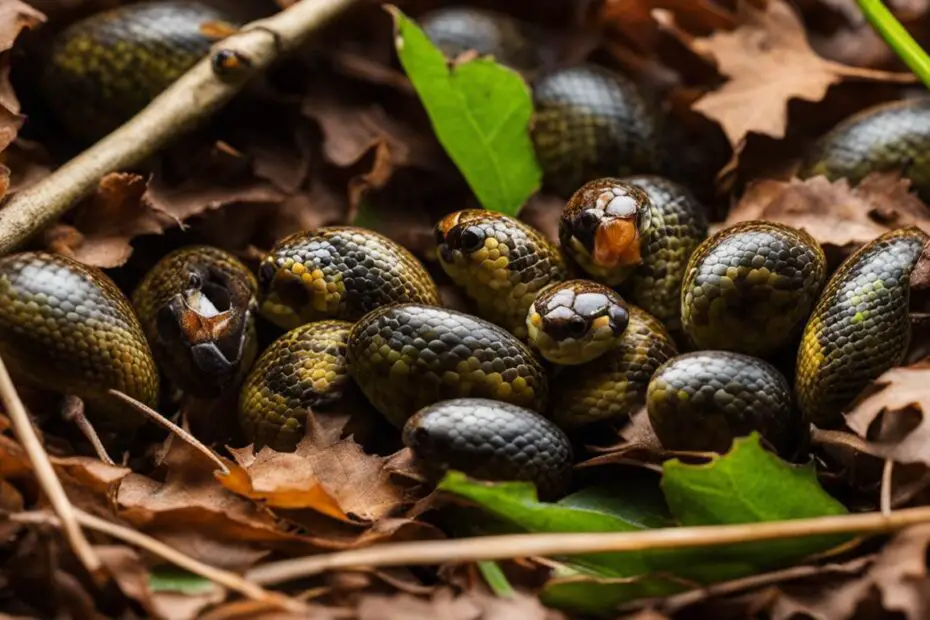When it comes to snake reproduction, there’s more than meets the eye. While many people assume that all snakes lay eggs, the truth is quite intriguing. Some snakes actually give birth to live young through a process called ovoviviparity. Let’s explore the fascinating world of snake reproduction and uncover the facts.
Key Takeaways:
- Not all snakes lay eggs; some give birth to live young.
- Oviparous snakes lay eggs that need to be incubated.
- Viviparous snakes give birth to live young without the use of eggs.
- Ovoviviparous snakes develop eggs inside their bodies and give birth to live young.
- Snake reproduction showcases unique adaptations for survival.
Oviparous Snakes – Laying Eggs
Approximately 70% of snake species are oviparous, which means they lay eggs as a part of their reproduction process. These eggs require careful incubation until the hatchlings are ready to emerge. Let’s explore the fascinating world of oviparous snakes and their unique breeding characteristics.
Types of Oviparous Snakes
There are several common examples of oviparous snakes. Some well-known species include:
- Rat Snakes
- Grass Snakes
- Kingsnakes
- Cobras
- Mambas
- Adders
Each of these snakes lays eggs as a means of reproducing, ensuring the continuation of their species.
Incubation and Parental Care
Once the eggs are laid, typically in a safe and secure location, the female snake tends to abandon them. However, it’s worth noting that some species, such as the king cobra, show parental care by coiling around the eggs to protect and incubate them. This behavior is not commonly observed among oviparous snakes, making it a remarkable exception.
The duration of incubation time varies depending on the snake species and environmental conditions. Factors such as temperature and humidity play a crucial role in the development of the eggs. These conditions mimic the natural environment and help the embryos grow until they are ready to hatch.
Visualizing Oviparous Snakes and their Eggs
To give you a clearer understanding, let’s visualize the eggs of oviparous snakes. Below is an image that showcases the eggs of a rat snake:

“Laying eggs is a fundamental part of the reproductive journey for many snakes. It’s remarkable to see how oviparous snakes develop and protect their eggs until it’s time for the hatchlings to emerge.”
– Dr. Samantha Reynolds, Herpetologist
Understanding the process of egg-laying and incubation in oviparous snakes provides valuable insights into snake breeding and the complexity of reptile reproduction.
Viviparous Snakes – Live Birth with No Eggs
While the majority of snake species lay eggs, there are some that give birth to live young, a method of reproduction known as viviparity. Unlike other reptiles, viviparous snakes nourish their developing offspring through a placenta and yolk sac, a unique characteristic that sets them apart in the animal kingdom.
Some well-known examples of viviparous snakes include boa constrictors and green anacondas. These massive creatures carry their young inside their bodies until they are ready to be born. Once born, the baby snakes are fully active and independent, as there is no parental protection or care in the snake world.

This fascinating method of reproduction in viviparous snakes is a testament to their remarkable adaptability. Unlike oviparous snakes that rely on external conditions for egg incubation, viviparous snakes have the advantage of internal development and protection.
“Viviparous snakes are an incredible example of nature’s diversity and adaptability. The ability to give birth to live young without the need for eggs has allowed these snakes to thrive in various environments.”
One notable feature of viviparous snakes is the advanced development of their offspring at birth. Baby rattlesnakes, for instance, are born with fully functional fangs and venom, equipping them to be formidable predators from the moment they enter the world.
The Evolutionary Advantage of Viviparity
While the exact reasons for viviparity in snakes are still being studied, it is believed that this method of reproduction offers several advantages. By giving birth to live young, viviparous snakes are able to:
- Ensure higher survival rates by providing better protection and care for their offspring
- Colonize different habitats, including areas that may be too cold for eggs to survive
- Reduce the risk of predation by avoiding the vulnerability associated with egg-laying and incubation periods
The evolution of viviparity in snakes represents an extraordinary adaptation that allows these reptiles to thrive in diverse environments across the globe. Understanding the complexities of snake reproduction, including viviparity, sheds light on the incredible diversity and wonders of the natural world.
Ovoviviparous Snakes – Eggs Hatch Inside the Female
Ovoviviparous snakes, a fascinating group of reptiles, have a unique reproductive strategy that combines elements of egg-laying and live birth. Instead of laying their eggs externally like oviparous snakes, female ovoviviparous snakes retain the eggs inside their bodies until the young snakes are ready to be born. This process of internal incubation provides certain advantages for the developing embryos.
One example of an ovoviviparous snake is the rattlesnake. Female rattlesnakes carry their eggs for several months within specialized structures called oviducts. These eggs develop and hatch inside the female’s body, resulting in the birth of live young. This reproductive method ensures that the hatchlings are more advanced in their development compared to oviparous animals, allowing them to be fully active and live right from the moment of birth.
The adaptation of ovoviviparity provides several benefits to ovoviviparous snakes. First, the embryos receive protection and a stable environment throughout their development, as they are shielded within the female’s body. This offers increased protection against predators and environmental fluctuations.
Furthermore, ovoviviparity allows ovoviviparous snakes to inhabit a wider range of habitats compared to purely oviparous species. By retaining the eggs internally, these snakes are not limited by the availability of suitable nest sites. This flexibility contributes to the success and survival of ovoviviparous snake species.
When the young snakes are fully developed and ready to be born, the female ovoviviparous snake gives birth to live hatchlings. These baby snakes emerge from the mother fully active and independent, equipped with all the necessary skills for survival. Unlike viviparous snake species that have parental protection, ovoviviparous snake hatchlings must rely solely on their innate instincts and abilities to navigate their surroundings.
To summarize, ovoviviparous snakes exhibit a remarkable reproductive strategy in which the eggs develop and hatch inside the female’s body. This adaptation allows for increased protection and developmental advancement of the hatchlings. Ovoviviparity is a fascinating aspect of snake reproduction, showcasing the diverse and ingenious ways in which snakes ensure the continuation of their species.

| Reproductive Strategy | Description | Examples |
|---|---|---|
| Oviparous | Snakes lay eggs externally, which require incubation until hatching. | Rat snakes, kingsnakes, cobras |
| Viviparous | Snakes give birth to live young without the use of eggs, nourishing them through a placenta and yolk sac. | Boa constrictors, green anacondas |
| Ovoviviparous | Snakes develop eggs inside their body and retain them until the young snakes are ready to be born. | Rattlesnakes |
Different Methods of Reproduction in Snakes
Snakes have three distinct methods of reproduction: oviparous, viviparous, and ovoviviparous. Each method has its own unique characteristics and adaptations.
Oviparous Snakes – Laying Eggs
Oviparous snakes are the most common type of snake when it comes to reproduction. These snakes lay eggs that need to be incubated until they hatch. The female snake will typically find a suitable location to lay her eggs, such as a burrow or a warm, secluded spot. Once the eggs are laid, the female abandons them and does not provide any further care.
Here are some examples of oviparous snakes:
- Rat snakes
- Grass snakes
- Kingsnakes
- Cobras
- Mambas
- Adders
Incubation time varies depending on the species and environmental conditions. Some species of snakes lay large clutches of eggs, while others may only lay one or two eggs at a time.
Viviparous Snakes – Live Birth with No Eggs
Viviparous snakes are a unique group of snakes that give birth to live young without the use of eggs. These snakes develop a placenta and yolk sac to nourish their developing young. This method of reproduction is highly unusual among reptiles and is more similar to the reproductive processes of mammals.
One example of a viviparous snake is the boa constrictor. Female boa constrictors give live birth to fully active and independent snake hatchlings. The babies do not receive any parental protection or care and are ready to navigate their environment immediately.
Ovoviviparous Snakes – Eggs Hatch Inside the Female
Ovoviviparous snakes represent a combination of egg-laying and live birth. These snakes develop eggs inside their body, but instead of laying the eggs externally, they retain them until the young snakes are ready to be born. The eggs hatch inside the female snake, resulting in the birth of live young.
Rattlesnakes are an example of ovoviviparous snakes. The female rattlesnake carries her eggs for several months before giving birth to fully active and live young. It’s important to note that the hatchlings of ovoviviparous snakes are more advanced in their development compared to oviparous snakes.

On the other hand, some snakes have evolved a different strategy known as viviparity. Viviparous snakes give birth to live young rather than laying eggs. This adaptation is particularly advantageous in colder climates where eggs may not survive. By giving birth to live young, viviparous snakes can provide warmth and nourishment to their offspring, increasing their chances of survival.
Lastly, there are snakes that exhibit a combination of both egg-laying and live birth, known as ovoviviparity. With this reproductive adaptation, female snakes develop eggs inside their bodies but retain them until the young snakes are ready to be born. Ovoviviparous snakes offer the benefits of both egg-laying and live birth, ensuring the survival and development of their young within the female’s body.
Reproductive Adaptations in Snakes
To summarize the different reproductive adaptations in snakes:
- Oviparous snakes lay eggs, allowing them to reproduce in various habitats.
- Viviparous snakes give birth to live young and provide warmth and nourishment.
- Ovoviviparous snakes develop eggs internally and give birth to live young.
These reproductive adaptations highlight the incredible diversity of snakes and their ability to thrive in different environments. They are a testament to the evolutionary success of these fascinating reptiles.
The Importance of Reproductive Adaptations
“The reproductive adaptations in snakes demonstrate their remarkable ability to adapt to diverse environments and ensure the survival of their offspring.”
Snake reproduction is a complex and fascinating subject that showcases the ingenuity and resourcefulness of nature. By understanding the different reproductive strategies and adaptations in snakes, we gain valuable insights into the diversity and resilience of these remarkable creatures.
Section 6 table: Snake Reproductive Adaptations
| Reproductive Adaptations | Description |
|---|---|
| Oviparity | Oviparous snakes lay eggs, enabling them to reproduce in various habitats. |
| Viviparity | Viviparous snakes give birth to live young, providing warmth and nourishment. |
| Ovoviviparity | Ovoviviparous snakes develop eggs internally and give birth to live young. |
The Fascinating World of Snake Reproduction
Snake reproduction is a fascinating and diverse subject. Different snake species exhibit various methods of reproduction, including laying eggs, giving birth to live young, or a combination of both. These unique reproductive strategies have evolved to ensure the survival of snake populations in different environments.
Female snakes play a crucial role in the production and care of their offspring. They invest significant energy in breeding, laying eggs or giving live birth, and protecting their young to ensure their survival. Snake mothers exhibit remarkable adaptations to provide the best conditions for their offspring.
Let’s explore the different methods of snake reproduction:
Oviparous Snakes – Laying Eggs
Oviparous snakes represent the majority of snake species, where females lay eggs that require incubation before hatching. The female snake carefully selects an appropriate location to lay her eggs, such as in a hidden nest or burrow. She ensures the eggs are protected from predators and environmental factors that could harm the developing embryos. Once laid, the female snake typically abandons the eggs and does not provide further care.
Other Methods of Snake Reproduction
While most snake species are oviparous, there are notable exceptions that exhibit different reproductive strategies:
- Viviparous snakes give birth to live young without the use of eggs. These snakes nourish their developing young through a yolk sac and placenta, similar to how mammals nourish their offspring. After a gestation period, the female snake gives birth to fully-formed and active baby snakes.
- Ovoviviparous snakes retain the eggs inside the female until they are ready to hatch. Unlike viviparous snakes, ovoviviparous snakes do not provide additional nourishment to the developing embryos through a placenta. Instead, the eggs are incubated inside the female until the young snakes hatch and emerge fully active.
The diversity in snake reproduction, with various methods and adaptations, adds to the intrigue and wonder of these remarkable reptiles. Understanding their reproductive strategies enhances our appreciation of their importance in ecosystems worldwide.
“The reproductive strategies of snakes showcase the incredible diversity and adaptability of these reptiles. From oviparity to viviparity and ovoviviparity, each method has evolved to ensure the survival of snake offspring in different environmental conditions.”
| Reproductive Strategy | Characteristic | Examples |
|---|---|---|
| Oviparous | Lay eggs externally | Rat snakes, grass snakes, cobras |
| Viviparous | Give live birth | Boa constrictors, green anacondas |
| Ovoviviparous | Retain the eggs, hatch inside the female | Rattlesnakes, garter snakes |
The table above summarizes the main reproductive strategies in snakes and provides examples of snake species for each category.
Snake breeding and reproduction are vital aspects of snake populations’ maintenance and contribute to the ecological balance of their habitats. By studying and appreciating the intriguing world of snake reproduction, we gain a deeper understanding of these magnificent creatures and the importance of their conservation.
Conclusion
In conclusion, the world of snake reproduction is filled with fascinating diversity. While approximately 70% of snake species are oviparous and lay eggs that require incubation, some snakes employ viviparity or ovoviviparity, giving birth to live young. This range of reproductive strategies allows snakes to adapt to various environments and ensure the survival of their offspring.
Snakes continue to captivate the attention of scientists and nature enthusiasts, serving as a reminder of the complexity and wonder of the natural world. Whether they lay eggs or give birth to live young, these reptiles exemplify the remarkable adaptability and reproductive strategies found in the animal kingdom.
From the coiling of king cobras around their eggs to the emergence of fully active hatchlings in rattlesnakes, snake breeding provides an intriguing glimpse into the intricacies of reptile reproduction. Understanding and appreciating the diverse methods of snake reproduction adds to our knowledge and appreciation of these remarkable creatures and their integral role in ecosystems worldwide.
FAQ
Do all snakes lay eggs?
No, not all snakes lay eggs. Approximately 70% of snake species are oviparous, meaning they lay eggs that need to be incubated until hatching. However, some snakes give birth to live young, either through viviparity or ovoviviparity.
What is the difference between oviparous, viviparous, and ovoviviparous snakes?
Oviparous snakes lay eggs that need to be incubated until the hatchlings are ready to emerge. Viviparous snakes give birth to live young without the use of eggs, nourishing them through a placenta and yolk sac. Ovoviviparous snakes develop eggs inside their body, but the eggs hatch inside the female, resulting in the birth of live young.
Can you give examples of oviparous snakes?
Examples of oviparous snakes include rat snakes, grass snakes, kingsnakes, cobras, mambas, and adders. After laying the eggs, the female snake typically abandons them, although a few species, like the king cobra, will coil around the eggs to protect and incubate them.
Which snakes give birth to live young?
Snakes that give birth to live young include boa constrictors and green anacondas. Once born, the baby snakes are fully active and independent, as there is no parental protection in the snake world. Baby rattlesnakes, for example, are born with fully functional fangs and venom.
What are ovoviviparous snakes?
Ovoviviparous snakes represent a combination of egg-laying and live birth. Female snakes that are ovoviviparous develop eggs inside their body, but instead of laying them externally, they retain the eggs inside until the young snakes are ready to be born. Rattlesnakes are an example of ovoviviparous snakes.
How do snakes reproduce in different environments?
Snakes have evolved various reproductive adaptations. Oviparous snakes lay eggs, allowing them to reproduce in a wider range of habitats. Viviparous snakes give birth to live young in colder climates where eggs may not survive. Ovoviviparous snakes combine aspects of both, ensuring the survival and development of their young within the female’s body.
Why is snake reproduction fascinating?
Snake reproduction is a fascinating subject because different snake species exhibit different methods of reproduction, including laying eggs, giving birth to live young, or a combination of both. Understanding the reproductive strategies and adaptations of snakes adds to our appreciation of these fascinating reptiles and their importance in ecosystems around the world.

